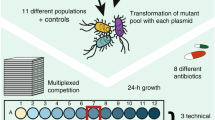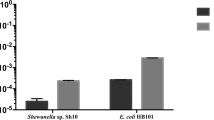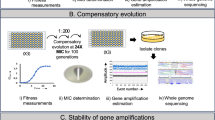Abstract
DRUG-BESISTANT bacteria can emerge from sensitive populations by acquiring a ‘resistance factor’ (R-factor)1,2 from another strain by conjugation. Genetically, an R-factor behaves as an extrachromosomal structure2 belonging to the same class of elements as the transmissible sex-factor (F)3,4 of Escherichia coli, and its derivatives (designated F′) in which a fragment of bacterial chromosome has become associated with F (ref. 5). In an R-factor a collection of genes determining resistance to one or as many as six different drugs is transferred as a single unit of inheritance linked to a resistance transfer factor (RTF) responsible for the transmission2.
This is a preview of subscription content, access via your institution
Access options
Subscribe to this journal
Receive 51 print issues and online access
$199.00 per year
only $3.90 per issue
Buy this article
- Purchase on Springer Link
- Instant access to full article PDF
Prices may be subject to local taxes which are calculated during checkout
Similar content being viewed by others
References
Watanabe, T., and Fukasawa, T., J. Bact., 81, 669 (1961).
Watanabe, T., Bact. Rev., 27, 87 (1963).
Hayes, W., J. Gen. Microbiol., 8, 72 (1953).
Lederberg, J., Cavalli, L. L., and Lederberg, E. M., Genetics., 37, 720 (1952).
Jacob, F., and Adelberg, E. A., C. R. Acad. Sci., Paris, 249, 189 (1959).
Ørskov, I., and Ørskov, F., Acta Path. Microbiol. Scand., 48, 37 (1960).
Loeb, T., and Zinder, N. D., Proc. U.S. Nat. Acad. Sci., 47, 282 (1961).
Brinton, C. C., Gemski, P., and Carnahan, J., Proc. U.S. Nat. Acad. Sci., 52, 776 (1964).
Sugino, Y., and Hirota, Y., J. Bact., 84, 902 (1962).
Hirota, Y., Nishimura, Y., Ørskov, F., and Ørskov, I., J. Bact., 87, 341 (1964).
Watanabe, T., Fukasawa, T., and Takano, T., Virology, 17, 218 (1962).
Watanabe, T., Nishida, H., Ogata, C., Arai, T., and Sato, S., J. Bact., 88, 716 (1964).
Watanabe, T., and Fukasawa, T., J. Bact., 83, 727 (1962).
Watanabe, T., J. Bact., 85, 788 (1963).
Katznelson, H., and Sutton, M. D., J. Bact., 61, 689 (1951).
Cooper, S., and Zinder, N. D., Virology, 18, 405 (1962).
Dettori, R., Maccacaro, G. A., and Turri, M., Giorn. Microbiol., 11, 15 (1963).
Author information
Authors and Affiliations
Rights and permissions
About this article
Cite this article
MEYNELL, E., DATTA, N. Functional Homology of the Sex-Factor and Resistance Transfer Factors. Nature 207, 884–885 (1965). https://doi.org/10.1038/207884a0
Issue Date:
DOI: https://doi.org/10.1038/207884a0
This article is cited by
-
The kinetics of inhibition of Flac transfer by R100 in E. coli
Molecular and General Genetics MGG (1974)
-
Characterisation of derepressed mutants of an F-like R factor
Molecular and General Genetics MGG (1973)
-
Fertility functions of resistance factors
Molecular and General Genetics MGG (1973)
-
The nature of the transfer inhibitor of several F-like plasmids
Molecular and General Genetics MGG (1972)
-
R factor compatibility groups
Molecular and General Genetics MGG (1972)
Comments
By submitting a comment you agree to abide by our Terms and Community Guidelines. If you find something abusive or that does not comply with our terms or guidelines please flag it as inappropriate.



